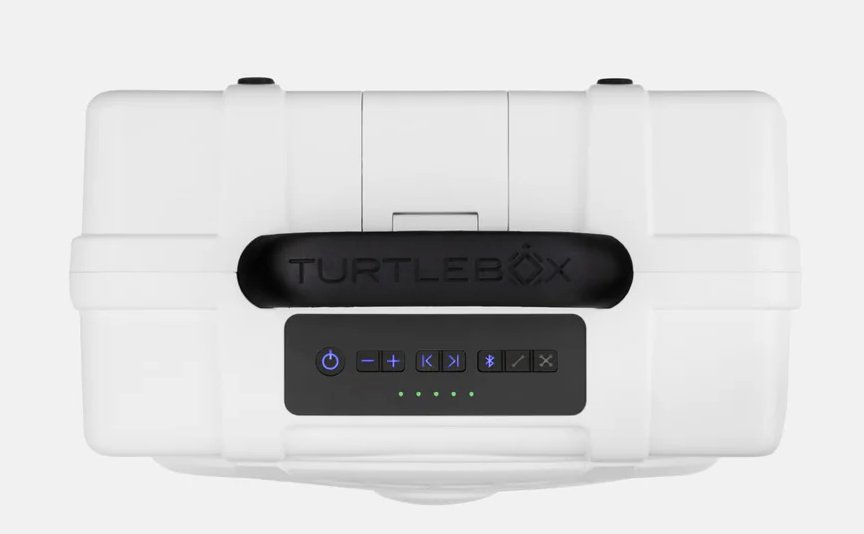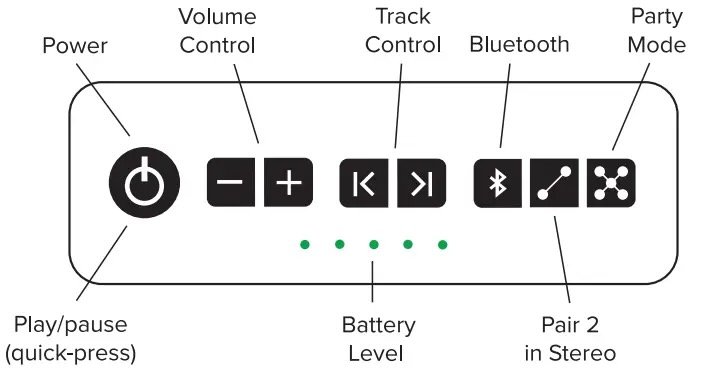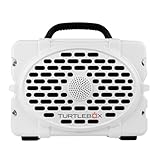The Turtlebox Gen 3 Is Just The Gen 2, But With Newer Bluetooth & Better Multispeaker Pairing
Three years after the release of the Turtlebox Gen 2, the 3rd generation has arrived. But before you reach for your wallet, there are some important details to consider, especially if you already own the Gen 2.
The Turtlebox Gen 3 is almost identical to its predecessor, except for its wireless connectivity and multi-speaker pairing. It has been upgraded to the latest Bluetooth 5.4 and now allows TWS pairing with the Turtlebox Grande, Ranger, and additional Gen 3 units. It also now supports Party Mode, for those wanting to connect more than two Turtlebox speakers.
If you’re looking for a detailed review of the Gen 3, you’ve come to the right place. Let’s take a look at how the Turtlebox Gen 3 performs and what it has to offer.
Key Takeaways
- Minor improvements from the previous Turtlebox.
- Durable and lightweight, designed for the outdoors.
- Distinct sound signature for more outdoor coverage.
- Battery life is good, but drops significantly at full volume.
Turtlebox Gen 3
What I Like:
- Extremely loud for its size.
- Large array of color options.
- Sound profile excels outdoors.
- Infinite pairing potential with other Turtlebox speakers.
What I Don’t Like:
- Barely any changes from the Gen 2.
- No companion app.
- No EQ toggle for sound adjustments.
- Could do with deeper bass.
Design & Portability: A Lunchbox Style Design Available in Plenty of Colors
- Lots of different colors are available.
- Relatively compact and light speaker, easy to carry in one hand.
The Turtlebox Gen 3 has the iconic Turtlebox lunch-box style design with a built-in carry handle. Since it weighs only 10 pounds and measures 11.5 x 8.75 x 6.5 inches, it isn’t a burden to carry around.
The highly portable design is key to the brand. After all, there are a lot of loudspeakers out there, but most are far too large for casual use outdoors. Turtlebox carved out a niche by bringing big volume into an easy-to-carry shell.
Although simply aesthetic, the Gen 3 comes in a ton of different color combinations that give it flair and personality. Directly from retailers like Amazon, you’ll be able to select between at least 8 different color combos, while if you buy directly from Turtlebox, there are more than 50 different color combinations to choose from, as one can pick a custom handle and body color.
Durability: One of The Strongest Speakers Available
- Extremely well-made, with strong plastic.
- Doesn’t need to be pampered; toss it around if you like.
Rough, rugged, and loud is the entire identity for the Turtlebox, and it has been since the first generation launch. It’s one of the reasons why so many outdoor enthusiasts opt for the Turtlebox over something like the JBL PartyBox 120.
The plastics used for the shell are thick, extremely strong, and do well at preventing excessive scratches, even during challenging outdoor use. Since the front grille is made from these same materials rather than a generic metal mesh grille, it can take knocks that most other speakers can’t.
Toss it in the back of your pickup, strap it to your boat, or tie it to the back of your quad bike – that’s what it’s made for. It even has some incredibly durable, metal tie-down slots so you can strap it down firmly.
Waterproofing: Dip it, Dunk It – It Doesn’t Matter
- IP67 waterproof rating protects it from dust and water.
When Turtlebox was first released, its IP67 rating was ahead of its time. There were barely any speakers on the market offering such high levels of waterproofing and general durability.
Surprisingly, the Turtlebox Gen 3 retains this same IP67 rating. I expected Turtlebox to upgrade it to IP68, especially since some of JBL’s newer releases, like the Flip 7 and Charge 6, have come out with IP68 water-resistance.
The difference isn’t significant, though, and even with IP67, you’re getting complete protection from water, including submergence up to a meter for 30 minutes.
Controls: Easy To Use and Comprehensive
- Easy-to-use controls with backlit LEDs.
- Battery indicator lights.
Controls are located at the top of the speaker and consist of a power button, volume up and down, track skipping, and three different pairing buttons: Bluetooth, TWS, and Party Mode.
The buttons themselves are backlit and quite durable, which is great, as I find it super frustrating to use some speakers in the dark.
The battery indicator under the LEDs is very useful too, providing an easy way to monitor when it’s time for the next charge.
Bluetooth: The Latest In Wireless Connectivity
- Upgraded Bluetooth is mostly what separates this speaker from the Gen 2.
- The move to 5.4 facilitates multispeaker pairing and wireless security, but does little else.
The Turtlebox Gen 3 uses Bluetooth 5.4, an upgrade from its predecessor. The biggest benefit this upgrade brings is the fact that it was likely what facilitated Turtlebox’s new multispeaker pairing abilities.
The speaker holds connections well, even at a distance, which is essential for a dedicated outdoor speaker. During my time using Turtlebox speakers, I’ve never experienced issues with pairing or unstable connections.
You may be wondering if the upgrade to Bluetooth 5.4 has added new codec support using LE Audio. Unfortunately, not, and the truth is, very few speakers released with support for LE Audio actually support low-latency codecs.
Multispeaker Pairing: Pair It With As Many Supported Speakers As You Like
- Can be paired together with another Gen 3, Grande, or Ranger in TWS or Party Mode.
This is where the Turtlebox shines and separates itself from the Gen 2. Historically, one could pair two Turtleboxes together in a TWS pairing (stereo). But only two speakers.
The Turtlebox Gen 3 can be paired in stereo with another Gen 3, the Grande, or the Turtlebox Ranger. This is a really cool feature, as a lot of speakers I test still can only be paired in TWS with the same model.
If you only have two Turtlebox speakers, TWS is probably going to be your go-to. But the Gen 3 also supports connecting more than just two speakers together. Using the new “Party Mode”, it can be paired with an infinite number of supporting Turtlebox speakers (Gen 3, Grande, and Ranger).
No App Support
You may expect that with a price tag of $450 that the Turtlebox Gen 3 would come with a mobile app. Nope.
This is a bit surprising to me and something I highlighted in my review of the Gen 2 as a possible weak point.
I feel a companion app is important because the Turtlebox has such a distinct, outdoor-style sound profile that it reduces its quality indoors. A simple app with custom EQ and multispeaker pairing would be a massive boon.
Sound Quality: A Punchy Bass And An Outdoor Sound Signature
- A distinct outdoor sound that isn’t as appealing in a sealed room.
- Holds its clarity well when the volume is turned up, until around 85%.
- Not super bass-heavy, but it has a decent low punch.
Having tested dozens of Bluetooth speakers of all sizes, I must say that the Turtlebox is not a speaker I’d suggest for indoor use. It’s got a distinct outdoor tuning that makes it sound harsh in the confines of a room. Instead, this speaker is made to cut through wind and carry sound outdoors.
Is it a smooth, balanced-sounding speaker? No. Does it project sound well? Absolutely.
The thing about the Turtlebox Gen 3 is that if you’re an audiophile looking for the finest quality sound, you’re not going to find it. This speaker is made for a very specific type of person, someone who wants loads of power and ruggedness. But compared to the similar, yet much cheaper EcoXGear Defender, I prefer the sound of the Defender – especially since it has an EQ toggle. Ahem, Turtlebox…
It’s still a fairly bassy speaker, with a decent low-end thump, but since it’s just a single 6×9” driver covering the low and midrange frequencies, there’s a lack of deep bass that you’d get from a larger woofer.
Volume: Surprisingly Powerful For a Compact Speaker
- Although rated at 120 dB, it produces closer to 104 dB in real-world use.
So how loud does the Turtlebox Gen 3 get? While it’s advertised to produce up to 120dB, the truth is that number is measured through specialized lab testing and doesn’t really tell one how loud it is to the average person.
I used the MiniDSP UMIK-II measuring microphone and Room EQ Wizard to perform a decibel test at one meter and found readings were around 103-104 dB. This is still incredibly loud for a speaker of its size and is capable of covering a patio or pool area. Just don’t expect the same room-filling sound as something like the Soundboks 4 or JBL PartyBox Ultimate.
Battery: Up to 25 Hours, But Expect Close to 12 Hours in Most Situations
- At 50% volume, the speaker lasts close to 12 hours.
- At full volume, playtime is around 5 hours.
Playtime is rated at 25 hours, but this assumes a low listening volume. To test the battery out, I played audio at around 50% to see how long the Turtlebox lasted.
It gave around 10 to 12 hours at this volume, and again, is the same as that found on the 2nd generation Turtlebox.
At full volume, playtime was reduced to just over 5 hours.
A cool feature of the Turtlebox is its battery life indicator near the control panel, so you know when it’s time for a charge.
Charging takes relatively quickly, and is done through a charging port that’s situated under a protective compartment on the back of the speaker. Always make sure this is sealed when using the speaker around water.
What Are Some Similar Speakers To Consider, And How Does The Turtlebox Compare
With the Turtlebox Gen 3 replacing the Gen 2, it’s not worth considering the Gen 2 as an alternative. Instead, the closest speaker is the EcoXgear Defender, which we previously compared with the near identical Gen 2.
Comparing the Turtlebox to the EcoXgear Defender is a more versatile speaker, and if sound quality and flexibility are your primary concerns, then it’s well worth considering. However, when it comes to build quality, the Turtlebox Gen 3 is simply a stronger speaker that can take more of a beating.
Another option is the Turtlebox Grande, which is a larger, less portable but even louder alternative to the Turtlebox Gen 3, with more power and battery life. Instead of a 6×9” driver, it has a massive 10” woofer that also creates deeper bass.
Value & Conclusion
Overall, is it worth buying the Turtlebox Gen 3? And for owners of the Gen 2, is it worth upgrading?
If you’re an outdoors person who has an active lifestyle and needs a speaker that can take a knock and can get louder than other speakers of its size, then the Gen 3 is a pretty decent purchase. It’s not the best sounding speaker, but it balances relatively good sound quality with an incredibly durable shell.
If you already own the Gen 2, there’s no reason to upgrade unless you own other Turtlebox speakers that you’d like to pair it with. The new Bluetooth version offers very subtle improvements, but its biggest boon is the Party Mode pairing.
What’s important to consider is that the Turtlebox Gen 3 is $450, which is quite a steep price point and $50 more than its predecessor.



